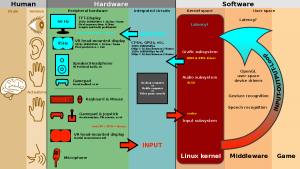Practical Considerations
How should the educator redirect learners during an enactment?
- Sometimes learners lose focus or become stalled while enacting a virtual simulation. The facilitator can use questions to redirect the learner and can directly or indirectly suggest different methods to work through the problem.
- A simulated overhead PA system can be built into the scenario using the facilitator as the voice of the PA. This may be useful when a direction needs to be conveyed to the learner without disrupting the flow of the scenario and is incorporated directly into the simulation itself. For example, learners using a simulated defibrillator forget to give the “all clear” command.

Expert’s Corner: Pearls of Wisdom
In this video interview, Dr. David Topps provides “Pearls of Wisdom” on virtual simulation. Hosted by Treva Job, Simulation Lead, Georgian College.
What are some practical considerations regarding enacting virtual simulations?
Participation in synchronous simulations requires learners to have reliable high-speed internet access, a computer/device (ideally with a webcam), and a headset with a microphone. An overview of the human-hardware-software components and process is shown in Figure 4.2.
Personal Computer:
Learners will need regular access to a computer, preferably a personal computer, with administrator privileges and be comfortable managing software and hardware. For an optimal experience learners need to have a laptop or desktop computer (Windows 10 or higher or Mac OS X 10.14 or higher is recommended). They may need to verify computer software if using a head mounted device as these often require the computer to have a graphics card and at least 8GB + RAM available to run the program software. Refer to the technical data sheets of the equipment being used for the virtual simulation for up-to-date technical requirements.
Head Mounted Device:
The most common head mounted displays that are available in educational settings include: Oculus RIFT, Oculus QUEST, and the QUEST2, Microsoft Halolens, or an Android or iOS phone in some instances. Generally cost is a factor for the institution but it does depend on who purchases the head set.
Internet Connection:
High speed broadband access (LAN, Cable or DSL) is highly recommended for an optimal learning experience. Note, that relying on a library or a café for internet access is not recommended.
A Web Browser is required for access to many learning systems and/or applications. In some instances it may be necessary for some users to upgrade their web browser programs. Refer to the technical data sheets for up- to- date browser requirements.
Speaker, and Headphones:
When enacting virtual simulations learners may have synchronous (live) online meetings using webinar software. It is preferable to use headphones with an attached microphone for these sessions.
Software:
Many courses require word processing software (such as Office 365).
As shown in Figure 4.2 In order for the learner to have a fully immersive experience the activity must meet the criteria shown in the diagram. This depends on the type of immersive experience you are looking for.
For example, in order for a student not to experience nausea during a virtual reality experience with a virtual headset (moving their head), the resolution must be less than 3 milliseconds. This is called pixel persistence. Moreover, this image shows the links between the human (learner), the equipment and the applications (experience) that is possible.
For alternative text description of Figure 4.2, please click the following link: Figure 4.2 Alternative Text Description
Figure 4.2: VR/AR Hardware, and Software Diagram


